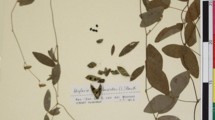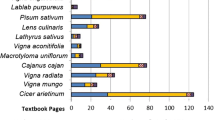Summary
-
1.
The wild species of the genusLens were surveyed. WildL. orientalis was found to be morphologically closest to cultivatedL. culinaris. It is also the only wild species interconnected to the cultivated lentil by a series of intermediate types.
-
2.
Archaeologically lentil was established as one of the primary domesticants that founded the neolithic agricultural revolution in the Near East are.
-
3.
The geographic distribution of wildL. orientalis is centered in the neolithic nuclear area of the Near East are, i.e., northern Israel, Syria, South Turkey, North Iraq, and Western Iran.
-
4.
The conclusion was reached thatL. orientalis is the wild progenitor of cultivatedL. culinaris, and that its domestication took place in the Near East are.
Similar content being viewed by others
Literature Cited
Barulina, H. I. 1930. Lentils of the U.S.S.R. and other countries. Bull. Appl. Bot. Genet. Plant Breed. (Leningrad) Suppl. 40, 1–319.
Davis, P. H. and U. Plitmann 1970.Lens. In: Flora of Turkey. Vol. 3. Edited by P. H. Davis. Edinburgh Univ. Press, pp. 325–328.
Harlan, J. R. and D. Zohary 1966. Distribution of wild wheats and bailey. Science153: 1074–1080.
Helbaek, H. 1959. Domestication of food plants in the Old World. Science130: 365–372.
Helbaek, H. 1963. Late Cypriote vegetable diet in Apliki. Act. Instit. Athen. Reg. Sueciae. Ser. 4,VIII: 171–186.
Helbaek, H. 1966. Commentary on the phylogenesis ofTriticum andHordeum. Econ. Bot.20: 350–360.
Helbaek, H. 1969. Plant collecting, dry farming and irrigation agriculture in prehistoric Deh Luran.In: Hole, F., K. V. Flannary and J. A. Neely. Prehistory and Human Ecology of Deh Luran Plain. Mem. Mus. Anthrop. Univ. Michigan, No. 1, pp. 383–426.
Helbaek, H. 1970. The plant industry in Hacilar.In: Mellart, J. Excavations at Hacilar Vol. I. Occasional Publications No. 9 of the British Institute of Archaelogy, Ankara. Edinburgh Univ. Press, pp. 189–244.
Hopf, M. 1962. Bericht Uber die Untersuchung von Samen und Holzkohlenresten von der Argissa-Magula aus den präkermischen bis mittelbronzezeitlichen Schichten.In: V. Milojĉić, J. Boessneck und M. Hopf: Die Deutschen Ausgrabungen auf der Argissa-Magula in Thessalien. I. Rudolf Habelt Verlag, Bonn. pp. 101–119.
Hopf, M. 1969. Plant remains and early farming in Jericho.In: The Domestication and Exploitation of Plants and Animals. Edited by P. J. Ucko and G. W. Dimbleby. Duckworth and Company, London. pp. 355–359.
Renfrew, J. M. 1969. The archaeological evidence for the domestication of plants: methods and problems.In: The Domestication and Exploitation of Plants and Animals. Edited by P. J. Ucko and G. W. Dimbleby. Duckworth and Company, London. pp. 149–172.
Van Zeist, W. 1970. The Oriental Institute excavations at Mureybit, Syria: preliminary report on the 1965 campaign. Jour. Near East. Stud.29: 167–176.
Van Zeist, W. and S. Bottema. 1971. Plant husbandry in early neolithic Nea Nikomedeia, Greece. Acta Bot. Neerl.20: 524–538.
Zhukuvsky, P. M. 1964.Cultivated Plants and Thier Wild Relatives. Moscow (Russian).
Zohary, D. 1969. The progenitors of wheat and barley in relation to domestication and agricultural dispersal in the Old World.In: The Domestication and Exploitation of Plants and Animals. Edited by P. J. Ucko and G. W. Dimbleby. Duckworth and Company, London. pp. 47–66.
Zohary, D. 1971. Origin of southwest asiatic cereals: wheats, barley, oats and rye.In: Plant Life of South-West Asia. Edited by P. H. Davis et al. Bot. Soc. Edinburgh. pp. 235–263.
Author information
Authors and Affiliations
Rights and permissions
About this article
Cite this article
Zohary, D. The wild progenitor and the place of origin of the cultivated lentil:Lens culinaris . Econ Bot 26, 326–332 (1972). https://doi.org/10.1007/BF02860702
Received:
Issue Date:
DOI: https://doi.org/10.1007/BF02860702




